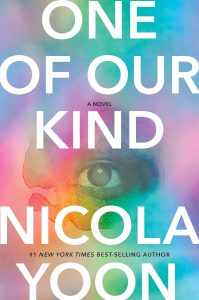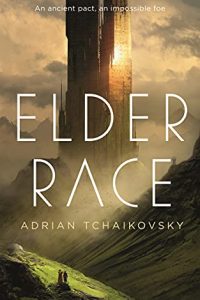One of Our Kind by Nicola Yoon: Review by Alex Brown
 One of Our Kind, Nicola Yoon (Knopf 978-0-59347-067-1, $28.00. 272pp, hc) June 2024.
One of Our Kind, Nicola Yoon (Knopf 978-0-59347-067-1, $28.00. 272pp, hc) June 2024.
Jasmyn, her husband Kingston, and their young son Kamau are excited to move to the new all-Black community of Liberty, just outside Los Angeles in Nicola Yoon’s One of Our Kind. King’s new job and higher income landed them a sprawling home in a luxury community where everyone from the retail workers to the cops to the wealthy residents are Black. Jasmyn is an attorney mostly working to help Black and brown defendants navigate the criminal justice system. Her entire life revolves around her growing family – she’s pregnant – and the fight for social justice. So it’s no surprise she’s shocked to discover that no one in Liberty seems to care when cops kill a Black child.
That’s not the only unsettling thing about the community. Little things that, taken on their own, are fairly harmless, but as they quickly pile up they merge into a bright neon sign flashing “Girl, Get Out Of There!” Women relax their hair and dress in muted pantsuits. The men care only about Liberty and showing off their prosperity. Former residents seem to vanish off the face of the earth, and her only two friends change their whole personalities overnight. And everyone who is anyone spends all their time at the mysterious Wellness Center that sits above the town like a master looking down from his tower. Something’s not right in Liberty, and if Jasmyn isn’t careful, she might never escape.
Readers going into One of Our Kind will pick up on the rich subtext Yoon utilizes if they’re knowledgeable not just about all-Black towns, but about late 19th and early 20th century Black scholarship on race relations. The story of Black-founded towns is a fascinating one that doesn’t get talked about much in US history classes. Known as all-Black towns or sometimes freedmen’s towns, these African American colonies were established by both freed Black folks and those born free. They popped up all over the place but especially the South and Southwest – including one in California, Allensworth, now a state park. Often they were created when African Americans purchased large plots of land then sold or rented out portions to other Black folks. Over time, a community would spring up, complete with Black-owned businesses, and all-Black churches, schools, and community spaces.
Many larger cities had all- or majority-Black neighborhoods, such as Greenwood in Tulsa, Oklahoma, also known as Black Wall Street, or Harlem in New York. Some were townships in unincorporated areas, such as Africatown, Alabama, which was founded by the survivors of the last slave ship to arrive in the US, the Clotilda. Zora Neale Hurston interviewed one of the founders, Oluale Kossola (also known as Cudjoe Lewis) who recounted not just his life in Africatown but his childhood in West Africa and his enslavement in the US; the manuscript was posthumously published in 2018 as Barracoon: The Story of the Last “Black Cargo”.
Many of the all-Black communities founded in the 19th and 20th centuries are now gone. Some collapsed due to a lack of resources, like Allensworth, which was killed off by the railroads and a drought exacerbated by water being redirected away from the town to irrigate nearby farms, or Blackdom in New Mexico, ruined by drought and collapsing crop prices. Some were consumed by suburban sprawl and urban expansion of nearby cities, like Africatown and Weeksville in New York. Still others were intentionally destroyed, such as Seneca Village, which was seized by eminent domain to build Central Park, and Greenwood during the Tulsa Massacre in 1921.
All-Black communities were vital to our survival in the 19th and early 20th centuries. They were some of the only spaces where we could truly be ourselves. Self-determination is a key tenet of the Black power and civil rights movements. It shows up in conversations about Black nationalism and Black excellence, and is debated by everyone from Du Bois to Malcolm X to Martin Luther King Jr to Angela Davis and beyond. It’s even one of the Nguzo Saba of Kwanzaa. It is the call to define yourself and your community rather than letting others define you. It is why we built our own schools and churches – because white people wouldn’t let us attend theirs, or if they did, they ignored our history and culture. It’s why we established our own civic organizations like the California Colored Conventions, which agitated for civil rights from 1855-1865, and the Black Panther Party. And it is why we built our own neighborhoods and towns – because we wanted to do for ourselves instead of accepting the scraps that white people tossed aside. Yet we also built our own towns to show that we, too, could be “civilized,” that we were worthy of being treated as equals, that we could conform to white Western standards of “respectability.”
The reasons for establishing all-Black towns hold up less in 2024 than they did when Colonel Allensworth established his town in 1908, especially when you consider the geography. They could have set up shop in the predominantly Black neighborhoods of Baldwin Hills, Ladera Heights, Windsor Hills, and View Park, known colloquially as the Black Beverly Hills. Or they could’ve gone to one of the many all-Black or mostly Black towns in the South and used their wealth to help bring in services and resources to these often isolated and poor communities. Instead, Yoon cleverly has them choose a bougie enclave in one of the most expensive regions in the state. Gates and armed security guards isn’t how you demonstrate community or self-determination. That right there, Jasmyn, is a major red flag.
Yoon deftly digs into the long-running intracommunity discussions between assimilationists and Black nationalists, between revolutionaries and those pushing respectability politics, and between W. E. B. Du Bois’s “talented tenth” ideology and Booker T. Washington’s “go slow” philosophy. In his memoir Up From Slavery, Washington wrote “No white American ever thinks that any other race is wholly civilized until he wears the white man’s clothes, eats the white man’s food, speaks the white man’s language, and professes the white man’s religion.” Although he was talking about Indigenous people (he was a big proponent of Indian Boarding Schools and even worked as a “house father” at Hampton Institute in Virginia during its “Indian Experiment” period 1878-1923), that same sentiment can be applied to what many Black folks thought then and now. It’s the idea that if we play by white people’s rules, then we’ll be safe from racism. But it never works that way. Viola Davis still struggles to get leading roles despite leading a hugely popular TV show and being one of the few actors to EGOT. Meghan Markle suffered so much racism despite having light skin and Eurocentric features that it ran her and her white royal husband out of the country. Wealthy Black people still get pulled over by the cops and accused of being affirmative action applicants at Ivy Leagues. Pickmes, uncle toms, and proximity to whiteness only get you so far. It doesn’t matter how “respectable” you are, you’re still a Black person in a white Western society built to keep you down.
When Nina Marks says being Black is a problem, my mind immediately went to Malcom X’s 1963 speech “Message to the Grassroots”: “America’s problem is us. We’re her problem. The only reason she has a problem is she doesn’t want us here. And every time you look at yourself, be you black, brown, red, or yellow – a so-called Negro – you represent a person who poses such a serious problem for America because you’re not wanted.” However, the Liberty people failed to remember the rest of that speech. He wasn’t saying the problem is Blackness specifically, but that white America sees us as a problem. Or, in the 1962 words of James Baldwin:
White Americans find it as difficult as white people elsewhere do to divest themselves of the notion that they are in possession of some intrinsic value that black people need, or want. And this assumption… makes the solution to the Negro problem depend on the speed with which Negroes accept and adopt white standards… It is the Negro, of course, who is presumed to have become equal…. Therefore, a vast amount of the energy that goes into what we call the Negro problem is produced by the white man’s profound desire not to be judged by those who are not white, not to be seen as he is, and at the same time a vast amount of the white anguish is rooted in the white man’s equally profound need to be seen as he is, to be released from the tyranny of his mirror.
Later Marks tries to handwave her statement away, and Jasmyn, for some inexplicable reason, buys it. If she were just a little more aware, she’d see that Marks is literally giving the game away. (Fun fact: Washington and Du Bois appeared in a 1903 essay collection entitled The Negro Problem.)
Jasmyn is the living embodiment of the Baldwin statement “to be a Negro in this country and to be relatively conscious is to be in a state of rage almost all of the time,” whereas the Liberty founders have taken Washington’s approach to the extreme. We as a people cannot respectability politics our way into equity. Yet neither can we achieve equity through separatism. We are in this shitty system, whether we like it or not, and it doesn’t cease to exist simply because we stop acknowledging it – something Jasmyn is reminded of every time she heads to court or asks her husband if he plans to start mentoring underprivileged youths again. The people who benefit from that oppressive system will not relinquish power without pressure. We must have both a revolution and a coalition.
There’s another Baldwin quote I think is apt here: “What is it you want me to reconcile myself to?… You always told me it takes time. It has taken my father’s time, my mother’s time, my uncle’s time, my brothers’ and my sisters’ time, my nieces’ and my nephews’ time. How much time do you want for your ‘progress’?” It’s as if Jasmyn and the Liberty founders read that quote and had wildly different reactions; Jasmyn’s answer was to take to the streets and join BLM, while the Liberty founders decided to update Booker T. for the 21st century.
Like the Liberty founders, Jasmyn sees Liberty as her ticket to the American Dream: the picket fence, the nuclear family, the holiday decorations, and a house full of grandchildren. Where she dreams of doing all that as a Black family, the Liberty founders see the American Dream as a starting point rather than the end. Neither recognize that the American Dream isn’t meant for us. It was designed to exclude us. It is a tool for bulldozing Black and brown neighborhoods, gentrifying the poor out of a neighborhood, reinforcing compulsory heterosexuality, redlining and restrictive covenants. Too bad Jasmyn didn’t heed Baldwin’s clarion call, “The Negroes of this country may never be able to rise to power, but they are very well placed indeed to precipitate chaos and ring down the curtain on the American dream.” What will she have to sacrifice in order to achieve a dream not meant for her? At the same time, is it so wrong to want something that everyone else has and to try and make something good out of it?
Now, you’d think with all this fascinating nuance percolating in the background of One of Our Kind that I loved the book and give it 10/10 stars. Would that I could. The best way I can describe my experience reading this was that I was hooked until I was frustrated. The subtext Yoon imbued the story with was incredible. I could write a whole PhD dissertation on it. The problems for me came down to marketing and execution.
It has been marketed as horror, but it’s really more of a psychological thriller. The cover copy comps it to Get Out and The Stepford Wives, but for me those comps set the wrong expectations. A better comp would be a thriller like Alyssa Cole’s When No One Was Watching. Yoon’s novel is like Get Out in that both deal with Black folks in intense, race-based situations with horror elements… vaguely similar vibes but that’s about it. On the other hand, parts of the plot are so similar to Ira Levin’s 1972 novel The Stepford Wives that felt at times almost like an adaptation.
For most of the novel, I was right there with Jasmyn. I expect her to make excuses for the weird shit in Liberty and to brush aside her husband’s beige/pink flags; this is a thriller, after all. By the time she gets to Part Five and its climactic confrontation, I had no idea why she was doing what she was doing except that it got her to a similar situation as Joanna. Jasmyn is the kind of woman who is so entrenched in her wokeness that she has to be reminded that while hairstyles have historically been important to the Black community, sometimes “hair doesn’t need to make a statement.” She’s a woman who is accused, not always jokingly, of being “Blacker than thou.” The actions she takes leading up to the conclusion did not, to me, feel like what a Black woman like Jasmyn would do, even with a child at risk.
Think about Get Out. Black people often joke that if we were in a horror movie, we’d be the first to leave because no way are we going down into that basement to find out what is making that creepy sound. Writer and director Jordan Peele dissects that trope by having Chris comment directly on those intracommunity conversations. Peele establishes Chris’s background and motivations enough that it makes sense for him to participate in those tropes even though he and the audience knows it’s a bad idea. Yoon doesn’t quite clear that bar with Jasmyn. Get Out’s ending works because it’s in conversation with horror as a genre how the context of its tropes change when anti-Black racism is added into the mix. The Stepford Wives’s ending works because it’s in conversation with 1970s patriarchy and second wave feminism. Most of Yoon’s novel is in conversation with Blackness itself, but the ending seemed more interested in being shocking than sticking the thematic landing.
I think readers coming into One of Our Kind expecting a thriller will be mostly satisfied. Readers expecting a social horror novel (especially if they read a lot of horror by and about BIPOC) may be less so. The novel isn’t bad by any means. The narrative style is engaging, the pacing is quick and tense, and the premise is shockingly good. I just wish Yoon had done more with it. More horror, more intensity, and more willingness to follow through on her stellar premise.
Interested in this title? Your purchase through the links below brings us a small amount of affiliate income and helps us keep doing all the reviews you love to read!
Alex Brown is a librarian, author, historian, and Hugo-nominated and Ignyte award-winning critic who writes about speculative fiction, young adult fiction, librarianship, and Black history.
This review and more like it in the August 2024 issue of Locus.
 While you are here, please take a moment to support Locus with a one-time or recurring donation. We rely on reader donations to keep the magazine and site going, and would like to keep the site paywall free, but WE NEED YOUR FINANCIAL SUPPORT to continue quality coverage of the science fiction and fantasy field.
While you are here, please take a moment to support Locus with a one-time or recurring donation. We rely on reader donations to keep the magazine and site going, and would like to keep the site paywall free, but WE NEED YOUR FINANCIAL SUPPORT to continue quality coverage of the science fiction and fantasy field.
©Locus Magazine. Copyrighted material may not be republished without permission of LSFF.







